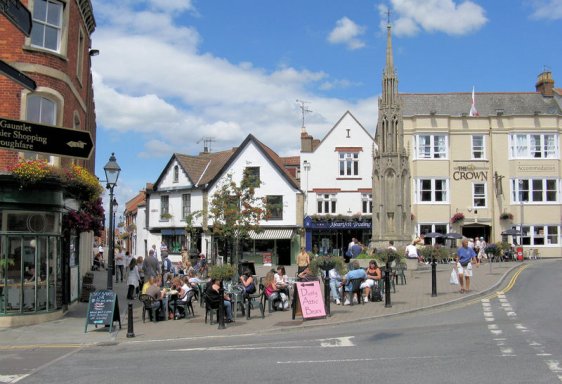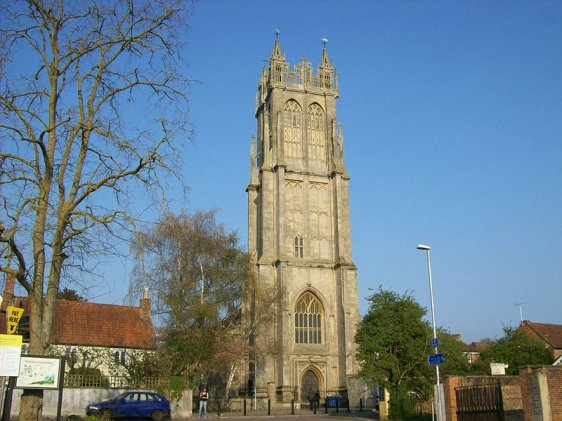 View of Glastonbury Tor from Street, Somerset: Source: https://en.wikipedia.org/wiki/File:Glastonbury_Tor_060404.jpg
View of Glastonbury Tor from Street, Somerset: Source: https://en.wikipedia.org/wiki/File:Glastonbury_Tor_060404.jpgAuthor: Wurzeller

Glastonbury is a small town in Mendip district, Somerset, England. Located on the River Brue 37 km (23 mi) to the south of Bristol, it has a population approaching 9,000 people (2012 estimate).
 Glastonbury, Somerset, England: Source: https://en.wikipedia.org/wiki/File:Glastonbury_town_centre_arp.jpg
Glastonbury, Somerset, England: Source: https://en.wikipedia.org/wiki/File:Glastonbury_town_centre_arp.jpgAuthor: Adrian Pingstone

Archaeological evidence suggests that the Glastonbury area has been inhabited since the Neolithic period. Wooden trackways discovered in the area, including Sweet Track, which was built around 3,807 BC, were some of the oldest engineered roads in Northern Europe, second only to the 6,000-year-old trackway discovered in 2009 at Belmarsh Prison in the Royal Borough of Greenwich, London.
Glastonbury is believed to have been founded during the Anglo-Saxon period, somewhere between the 7th and 8th century AD. It was originally known as Glestingaburg. The settlement is also known by the Old Celtic name of Ineswitrin, giving speculation that the site has been inhabited since Celtic times.
 Church of St John the Baptist, Glastonbury: Source: https://commons.wikimedia.org/wiki/File:St._John_the_Baptist,_Glastonbury.jpg
Church of St John the Baptist, Glastonbury: Source: https://commons.wikimedia.org/wiki/File:St._John_the_Baptist,_Glastonbury.jpgAuthor: Tony Grist

Under Saxon rule, Sharpham Park was granted by King Eadwig to the abbot Æthelwold in AD 957. After the Norman Conquest, the soon-to-be King John I of England granted it to the Abbots of Glastonbury, and it remained the possession of the abbey until the Dissolution of the Monasteries under King Henry VIII in 1539.
Since the 18th and 19th centuries, Glastonbury has developed into a tourist destination aided by its historic sights, myths and legends. Among the legends featuring Glastonbury include those concerning the Holy Grail, Joseph of Arimathea and King Arthur. The story of the Holy Grail was created by French poet Robert de Boron in the 13th century. There is also a legend that Glastonbury Abbey was founded by Joseph of Arimathea in the 1st century. In Arthurian literature, Glastonbury is identified as the legendary island of Avalon.
Visiting Glastonbury
From London, take the M4 motorway to Junction 20, then continue west on the M5 motorway to Junction 23. Head east on the A39 road until you reach Glastonbury.Places of Interest in Glastonbury
- Chalice Well: Holy well at the foot of Glastonbury Tor.
- Church of St John the Baptist: 15th century church today designated a Grade I listed heritage building.
- George Hotel and Pilgrims' Inn: Late 15th century inn built to accommodate pilgrims to Glastonbury Abbey. Today it is a Grade I listed building.
- Glastonbury Abbey: Ruins of monastery founded in the 7th century, though legends claim that it was founded by Joseph of Arimathea in the 1st century. The abbey was destroyed in a fire in 1184, rebuilt and then demolished during the Dissolution of the Monasteries under King Henry VIII in 1539.
- Glastonbury Lake Village: Preserved Iron Age village on the Somerset Levels, 5 km to the north west of Glastonbury.
- Glastonbury Tor: Hill in Glastonbury featuring the roofless ruins of St Michael's Tower.
- Ham Wall National Nature Reserve: Nature reserve managed by the Royal Society for the Protection of Birds, located 4 km to the west of Glastonbury.
- Sharpham Park: 300-acre historic park in the village of Sharpham, 3.2 km to the west of Glastonbury.
- Somerset Rural Life Museum: Museum offering a glimpse into the social and agricultural history of Somerset. It is housed in buildings surrounding a 14th century Grade I listed barn that once belonged to Glastonbury Abbey.
- Street: A small village about 3.2 km to the southwest of Glastonbury.
- Sweet Track: Ancient causeway claimed to be the second oldest timber trackway in Northern Europe.
- The Tribunal: Medieval merchant's house in Glastonbury.
 Latest updates on Penang Travel Tips
Latest updates on Penang Travel Tips

Copyright © 2003-2025 Timothy Tye. All Rights Reserved.

 Go Back
Go Back